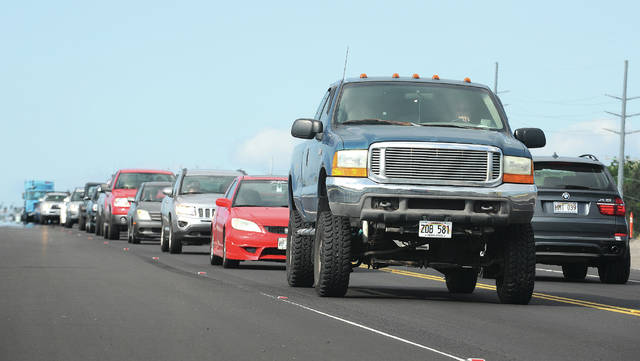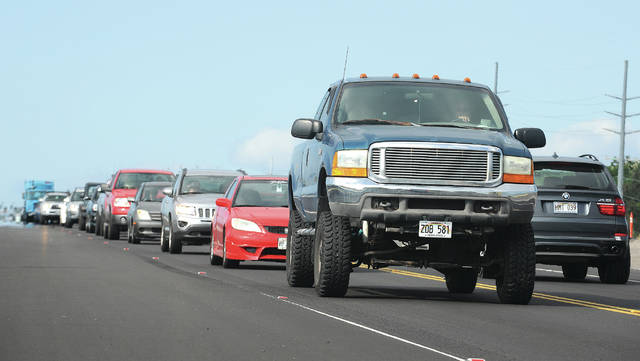KAILUA-KONA — Hawaii County is leading the state in motor vehicle traffic fatalities — trailing only Honolulu when it comes to overall roadway deaths — according to data released last week by the state Department of Transportation.
DOT’s report covered traffic fatalities from Jan. 1-Oct. 15 for the counties of Honolulu, Maui, Kauai and Hawaii.
The report also includes fatalities among pedestrians, operators of motorcycles, mopeds and scooters, and cyclists. Honolulu led the report with a total of 35 fatalities in all categories. Hawaii County trailed with 30.
Hawaii police Sgt. Brad Freitas said it’s not unusual for Hawaii County to place second behind Honolulu in overall traffic fatalities. And he isn’t surprised the Big Island had the most vehicle fatalities since the beginning of the year.
“I would say it’s just the dynamics of how our island is,” Freitas said. “We have more open highway with higher speed limits than Honolulu.”
Freitas said most of the Big Island’s crashes occur on two-lane, undivided highways at higher speeds.
Nationwide, Freitas said, speed and intoxication are leading causes of traffic fatalities, while distracted driving is a close third.
Freitas added there isn’t the congestion that there is in Honolulu, which allows people to speed on the open highways. Causes of car crashes are typically a result of speed, drifting or overtaking.
Freitas said police have seen a decrease in fatalities when the speed limits were decreased on Highway 190 back in 2004 or 2005.
“We changed the speed limit from 55 to 50 and it brought the crash count down,” he said.
On Oct. 14, there was a fatal car crash on the newly finished Daniel K. Inouye Highway, also known as Saddle Road. Freitas said he does think the highway poses a threat with its higher speeds and people trying to cut across the island quicker.
Other drivers on the road, however, were shocked by DOT’s statistics.
Julia Kuakahela of Kona was filling her car with gas Friday at the Ohana Fuels station at Hulikoa Drive. She was generally surprised how the roads have changed on the Big Island.
“I’ve lived here most of my life and the way people drive now is crazy,” she said. “There’s no aloha anymore — everyone’s on a mission.”
Kuakahela said just in the past two years it seems the traffic has gotten crazier.
“People are bumping, passing on the sides, blasting their horns at each other,” she said. “People need to learn to be patient — we’re gonna end up right behind each other anyway.”
Misha Sperka of South Kona has lived on the Big Island on and off since 1966. He was at Dixon’s 76 gas station on Friday when he commented about the increase of cyclists on the roadways.
“The Big Island is becoming a bicycling mecca,” Sperka said. “In many areas the side of the roads are so narrow, there’s no shoulder.”
He still thought the stats were surprising considering so many more people live in Honolulu and he thinks people are a little crazier on the roads there.
Cameron Hewines, a taxi driver on the Big Island for 10 years, also thought DOT’s numbers were surprising, but he does think traffic on the roadways on Hawaii Island is a serious issue. He said the problem area he sees is between Honokohau Harbor and Ellison Onizuka Kona International Airport at Keahole.
Through the years, Hewines said, the island’s roads have become more congested. He thinks it’s because of an increase of people moving here and tourism.
The fatalities, the taxi driver said, usually involve Hawaii residents and speeding.
“There’s some pretty crazy drivers out there overtaking unsafely,” he said.
Overall, Hewines thinks the roads are pretty good.
One Hawaii County resident who volunteers his time on several traffic safety councils disagrees with the others.
Ken Obenski is on the Kona Traffic Safety Committee and chairman of the Hawaii County Traffic Safety Council and the governor’s Highway Safety Council. He is passionate about roads on the Big Island.
He said the biggest problem is speed limits are too slow on some roads.
“This creates chaos,” Obenski said. “People are going to ignore the speed limit if it’s too slow. Some of our roads are just antiquated. They’re narrow, have no shoulders, and have sudden drop-offs.”
Obenski said another issue is slower drivers don’t get out of the way for faster drivers, which causes a buildup of vehicles.
“They are oblivious to what’s behind them,” Obenski said of the slower drivers. “This causes crazy driving because people get impatient.”
Hawaii Police Department provided updated crash and fatality statistics in its weekly DUI crash report, released Tuesday.
The report indicates a decrease in major accidents and a 25 percent increase for fatal motor vehicle crashes. There have been 1,068 major accidents so far this year compared with 1,109 during the same period last year, a decrease of 3.7 percent.
To date, the DUI crash report indicates there were 25 fatal crashes (one of which had multiple deaths), resulting in 27 fatalities, compared with 20 fatal crashes (three of which had multiple deaths), resulting in 23 fatalities for the same time last year. This represents an increase of 25 percent for fatal crashes and 17.4 percent for fatalities.
Tiffany DeMasters at tdemasters@westhawaiitoday.com.






